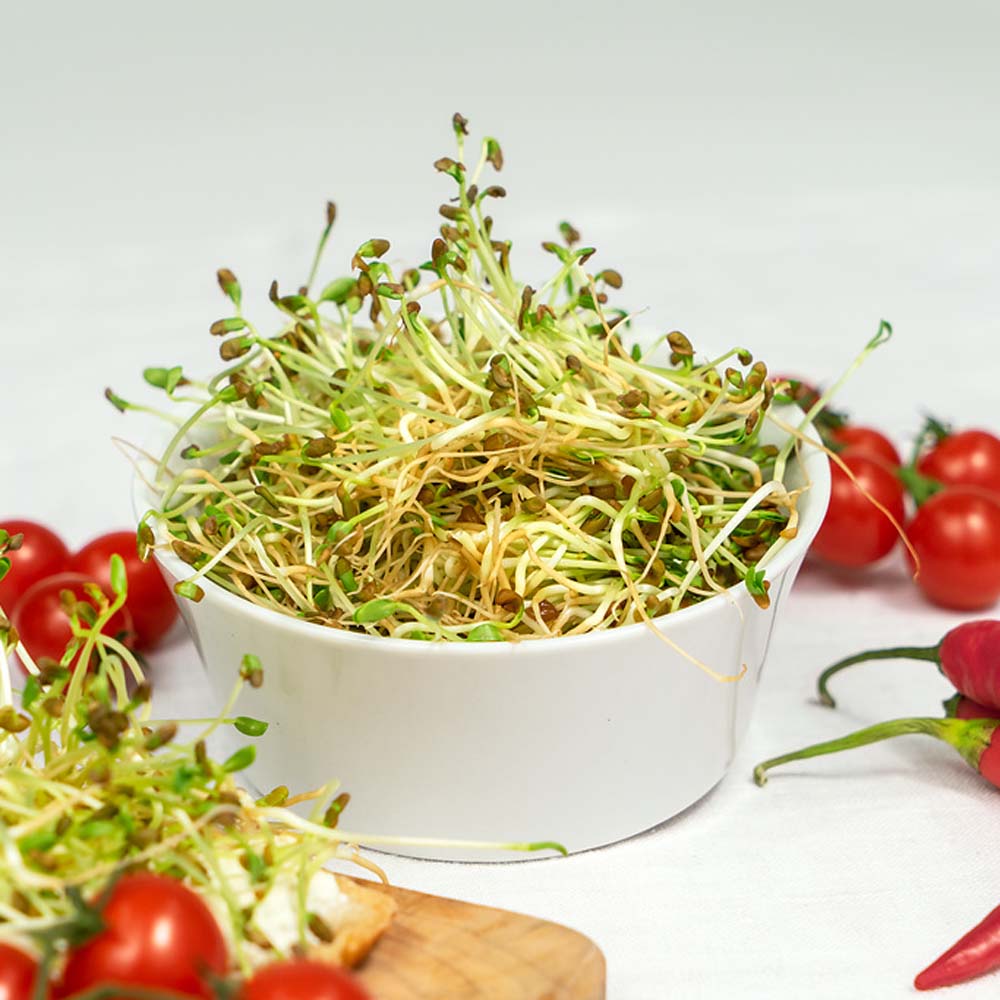Growing Microgreens From Seed
Microgreens are young plants which burst with flavor and beauty. Typically, microgreens are grown in trays and harvested at the seedling stage which occurs in no time at all. Here's how to get started:
Reasons to Grow
Growing microgreens provides year-round access to fresh produce, offers a fun indoor gardening hobby, and adds a unique flavor to dishes. Some have even turned this hobby into a business venture.
- Microgreens' seeds are simply seeds grown and harvested at the seeds first stage of development (sprouts), when the first leaves or cotyledons appear (microgreens) or when their true leaves have emerged (baby greens). Most herb and vegetable seeds can be grown as microgreens; however, only grow seeds listed for microgreens -- as some plants while producing delicious fruit have toxic leaves such as tomato's and pepper's
- Popular plant families for microgreens include brassicas like cabbage and mustard, but a wide array of plant families and species are suitable
- Unlike sprouting, microgreens require a growing medium like soil or a hydroponic pad
- The growing medium allows the roots to develop the plant structure; different mediums like jute or coco coir can be used as well
- Timing varies from a week to a month from seed to harvest, usually to the cotyledon or true leaf stage
- Growing microgreens past the true leaf stage can result in bitterness or a different plant type.
Getting Started
Be sure to checkout our page, "Microgreen and sprouts" growing instructions at
Growing MicroGreens and Sprouts Time to do a little shopping so you have all you need to get started growing your own microgreens.
Growing MicroGreens and Sprouts Time to do a little shopping so you have all you need to get started growing your own microgreens.
What you need
- Seeds
- Container to presoak seeds
- Potting soil or hydroponic mats
- Spray bottle for water
- Light or window
- Scissors
- Cover for your growing container
- Flat growing container 2-3 inches deep with drainage holes
Growing Microgreens for Beginners
- Pre-soak large seeds
Sunflowers, buckwheat, peas, beets and cilantro require a presoak for quick, even germination. Soaking time varies by species, so check package directions - Prepare trays for planting
Growing in Soil? Pre-moisten and firm 1.5-2 inches of soilless mix into your tray. Mist soil surface to dampen not soak.
Growing Hydroponically Add growing pad and water to your tray. Swiss and flip saturated pad. Make sure there are no dry spots then drain excess water. - Plant Seeds
Sprinkle seed evenly over surface of tray. Spacing depends on size of mature microgreens. Large seeds will almost be touching. Gently press seeds down to make good contact with growing medium - Mist and Cover
Mist the tray. Make a blackout/humidity chamber by misting the inside of a lid and cover the tray with a dark covering. Small containers can be placed inside a paper bag. Aluminum foil or a dinner plate will also work well to cover. - Mist Twice Per Day
Keep seeds moist by misting approximately every 12 hours. You should not need to add additional water to your trays at this stage. - Uncover Trays(s)
If your seeds have germinated (around 3-4 days), uncover tray. Place in a bright sunny location such as a window, a greenhouse, or under grow lights. - Check Daily
Check Moisture in your trays daily. Add water as needed to keep moist but not soggy. Seeds and seedlings can rot or get moldy if the soil is kept too wet and cold. Rotate tray(s) to keep seedlings growing straight.
Time to Harvest
Depending on which microgreens you are growing, they usually are ready to eat in 10 - 14 days. Use scissors to cut when ready. Add to salads and sandwiches for added flavor.

- Sprouts mark the initial phase of a seed's growth and typically do not require soil. They are sprouted and rinsed in a sprouting tray, jar, or bag. These young plants are best enjoyed shortly after germination for their delightful crunchy texture.
- Microgreens are usually cultivated in soil or another growing medium and represent the second phase of a plant's life, where roots develop and the initial leaves (cotyledons) emerge. Microgreens are harvested at this point before the full leaves (adult stage leaves) develop. During the microgreen stage, plants tend to have the highest flavor intensity and have absorbed trace elements and micronutrients from the soil.
- Baby greens are grown for a week or two longer than microgreens until their true leaves appear. These greens are harvested as young plants, capturing flavors closer to their mature stage and allowing them to absorb more micronutrients from the soil.































